| کد مقاله | کد نشریه | سال انتشار | مقاله انگلیسی | نسخه تمام متن |
|---|---|---|---|---|
| 1405865 | 1501760 | 2013 | 11 صفحه PDF | دانلود رایگان |

• Structure–spectroscopic relationship of rare chromone structures.
• Elucidation of ambiguous spectroscopic data of the keto–enol of barakol.
• Intermolecular interactions including H-bonds and pi–pi interactions were investigated.
Barakol, extracted from Cassia siamea Lamk. having an anxiolytic property, consists of a rare chromone core structure, therefore, in this work we investigate relation between the X-ray crystallography and physical properties such as spectroscopic data and the intermolecular interactions of the keto–enol forms based on the CSD search, especially e.g. hydrogen bonding, π–π interactions, ionic interactions and acid–base interactions and clarifies their ambiguous spectroscopic properties. The 1:1 molecular complexes of barakol and carboxylic acid (phthalic acid and 3-hydroxybenzoic acid) were prepared and the X-ray crystallographic studies revealed that the barakol-phthalate complex exists in an ion-pair complex. The formation of barakol-phthalate ion-pair complex is stabilized by the complementary of ion–ion interactions, π–π interactions and hydrogen bonding. The barakol-3-hydroxybenzoic acid complex is a π–π molecular complex. The co-crystallization of barakol-3-hydroxybenzoic acid complex is solely stabilized by π–π interactions. The spectroscopic studies including IR, 1H NMR and 13C NMR are consistent with the results from the X-ray analysis. The 1H NMR spectrum of the barakol and phthalic acid complex in a mixture of CDCl3–CD3OD showed a dramatic spectral changes with downfield shifts of the ortho-protons of phthalic acid (ΔδH(ppm) = 0.37), and the proton resonances of barakol (ΔδH(ppm) = 0.31 for proton H3, 0.53 for proton H4, 0.57 for proton H6 and 0.33 for proton H9).
Journal: Journal of Molecular Structure - Volumes 1054–1055, 24 December 2013, Pages 188–198